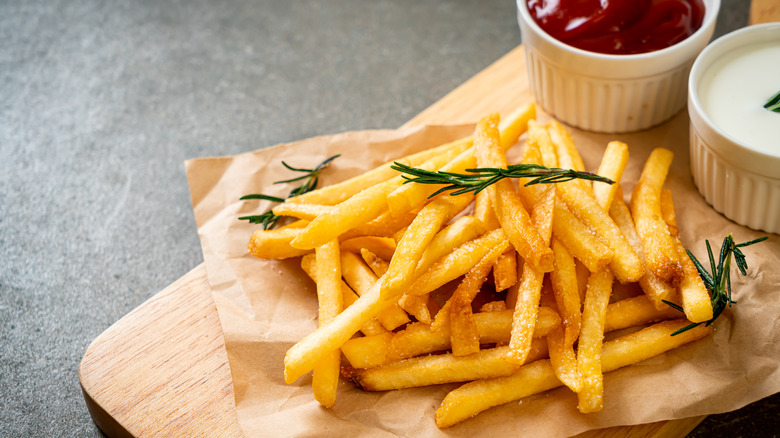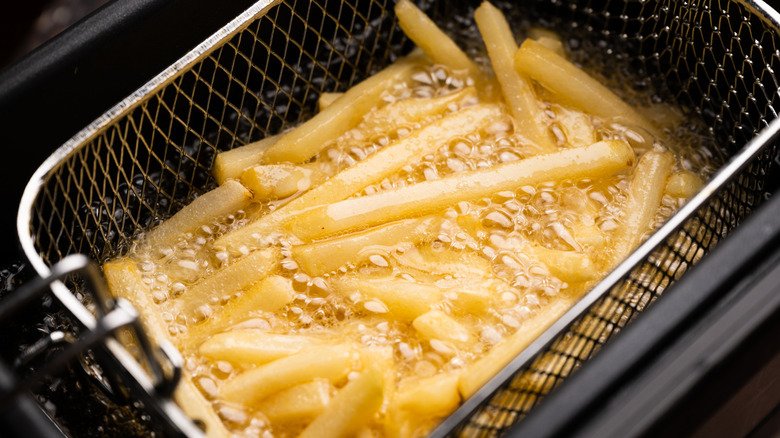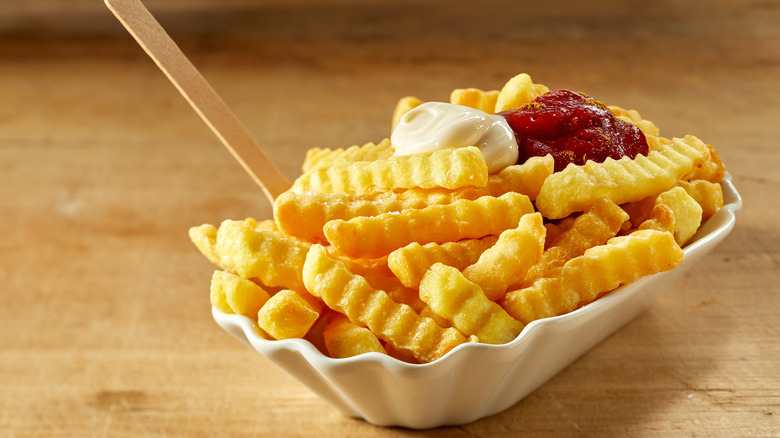The Science Behind Why Twice-Fried French Fries Are So Much Better
French fries are a good example of the same thing by another name. Whether you're a fan of fresh-cut fries, curly fries, or waffle fries, you're always eating a potato that's been sliced and fried. It doesn't matter if it's straight or curly, since it most likely comes from the same potato. But twice-fried French fries differ slightly from the tried-and-true formula of frying up sliced potatoes until they're golden on the outside and soft on the inside.
Twice-fried French fries, as the name implies, are French fries that have been fried not once, but twice. You've most likely seen them before as something called "shoestring fries," which are very thin "straws" of potatoes that have been deep-fried until they develop a taste and texture not unlike crunchy potato chips. It's obvious that deep-frying your French fries twice makes them crunchier, as would anything else if you were to deep-fry them twice. But just because they're crunchier doesn't automatically make them better, right?
While it's true that you could still get a really crunchy French fry even if you just deep-fry them once, there's actually something else that's special about these twice-fried taters. Unlike ordinary fries, which get soggy and greasy when left out, these twice-fried French fries will remain crispy and firm even if they've been left out for a few fours. What exactly is it about the deep-frying process that makes these fries so resilient against sogginess, even if they're just the same type of potato deep-fried twice?
Double-frying causes the starches on the potatoes to retrograde
When you follow any recipe for French fries, you probably hear about the "starch" on the potatoes. Starch is something that is found in most potatoes and is known for giving them that soft, fluffy texture (think mashed potatoes). When you remove starch, either by washing the potatoes in a cold water bath or blanching them in hot water, you can develop a crispier potato product — in this case, French fries.
The double-frying method is separated into two parts: the first fry and the second fry. The first fry both par-cooks the fries and removes any excess moisture from them. For example, if you're making frozen fries, there may be a bit of leftover water in them, so this first fry would help to remove any water that may be soaking into your fries. Once the potatoes are cooled down from the first fry, you can then start the second fry. This second fry causes the starch to "retrograde," or gelatinize, which allows the starch to be absorbed into the potatoes rather than sitting on the outside. This way, you not only get a crisper exterior, but a softer and fluffier interior thanks to the reintroduction of the nstarch.
Although you may not want too much starch on your potatoes if you want a crispy French fry, potato starch is actually a surprisingly good ingredient for when you're making fried chicken. After all, don't French fries and fried chicken usually go together?
Battered French fries also follow a similar process
When you're out at a restaurant, you notice that the basket of fries you ordered seems to be crispier than you thought. There are also little crunchy bits of what seems to be fried batter scattered around the bottom of the basket. Your fries are covered in what can only be described as a thin tempura-like batter, which would explain the significantly crunchier exterior.
Battered French fries follow almost the exact same method of double-frying that ordinary double-fried fries follow. A standard recipe for beer-battered fries, for example, may have you par-cook the fries in oil for about five minutes or until the fries have developed a golden-blonde exterior. This first fry not only removes excess water as mentioned before, but the par-cooking process means that when the fries have been covered in batter, they will cook much faster, If the fries weren't par-cooked, they would take longer to fry and the batter would burn before the fries could be considered done. This way, you're getting the crispy batter-covered exterior, while also keeping the inside nice and fluffy without burning the batter or the fries.
The key to double-frying is more or less about time, and will take some practice to get right. Whether you're dipping them in batter or slicing them as thin as can be, your fries will still be crispy long after you take them out of the fryer.


